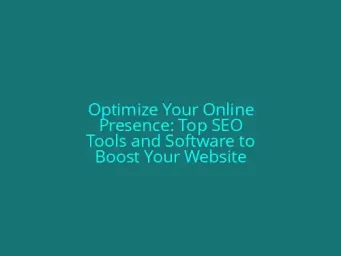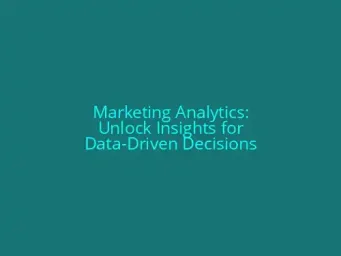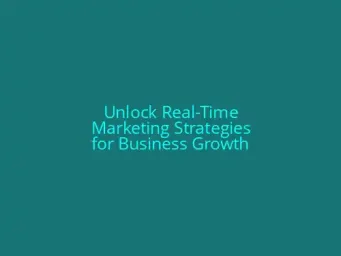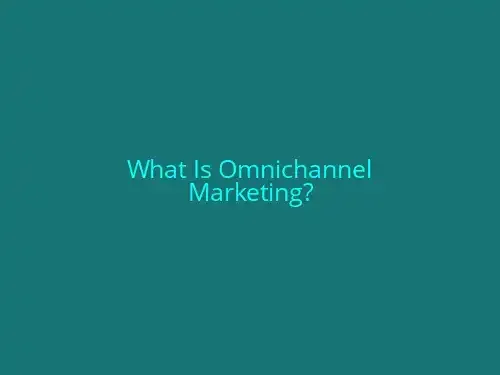
What Is Omnichannel Marketing?
Here is the content for Section 1: **Introduction to Omnichannel Marketing**.\n**What Is Omnichannel Marketing? A Complete Guide**\n### Title: What Is Omnichannel Marketing? A Complete Guide\n### Meta Description: Learn how omnichannel marketing strategies can enhance customer experiences and boost sales. Discover the benefits, key components, and steps to implement a successful omnichannel marketing strategy.\n### Word Count: 1,200-1,500 words\n### 1. Introduction to Omnichannel Marketing\n### Definition of Omnichannel Marketing\nOmnichannel marketing is a marketing strategy that integrates multiple channels to provide a seamless and cohesive experience for customers. The term omni means all, and channel refers to the various ways customers interact with a company, such as physical stores, the internet, social media, emails, mobile apps, and more. This approach allows customers to switch between channels without interruption, ensuring a consistent brand experience.\n### Importance in Modern Marketing Strategies\nIn todays digital landscape, omnichannel marketing is crucial for businesses to stay competitive and build strong customer relationships. The key benefits include enhanced customer experiences, increased brand recall and customer loyalty, improved sales and revenue, and better data collection and analysis.\n### Brief Overview of the Article\nThis article will provide a comprehensive guide to omnichannel marketing, including its key components, benefits, and steps to implement a successful strategy. We will explore the differences between omnichannel and multichannel marketing and offer practical examples and best practices for creating an omnichannel marketing strategy that drives business results.### 2. Key Components of Omnichannel Marketing\n#### a. Customer Personas and Journey Mapping\nOmnichannel marketing starts with understanding the customer. This involves creating detailed customer personas that outline their needs, preferences, and pain points. This data is used to map the customer journey, which outlines the steps a customer takes from discovering your brand to purchasing from it. Mapping these stages helps you tailor your marketing efforts to each customer segment.\n#### b. Content Planning and Creation\nContent is crucial in omnichannel marketing. It must be consistent across all channels and tailored to specific customer segments. This includes creating blog posts, social media posts, email newsletters, and other content that aligns with the customer journey. Content must be high-quality, engaging, and informative to capture and retain customer attention.\n#### c. Channel Selection and Integration\nSelecting the right channels is vital. This includes both digital and physical channels that align with your brand identity and customer preferences. Integration involves connecting these channels seamlessly so that customers can switch between them effortlessly. For instance, allowing customers to purchase online and pick up in-store.\n#### d. Assignment of Responsibilities and Resource Management\nAssigning responsibilities and managing resources is key to executing an omnichannel strategy. This includes designating roles, setting budgets, and allocating personnel. Effective resource management ensures that each channel is adequately supported and that customer interactions are seamless.\n#### e. Continuous Testing and Adaptation\nOmnichannel marketing is not a one-time event. It requires continuous testing and adaptation to ensure that your strategy remains effective. Monitor key performance indicators such as conversion rates, customer retention, and lifetime value. Conduct A/B tests and optimize campaigns based on findings to improve the overall customer experience.\nThese key components ensure that your omnichannel marketing strategy is customer-centric, engaging, and aligned with your business goals. By following these steps, you can create a cohesive marketing approach that enhances customer experiences and boosts sales.### 3. Benefits of Omnichannel Marketing\nOmnichannel marketing offers numerous benefits that enhance customer experiences and drive business growth. Here are some of the key advantages:\n#### Enhanced Customer Experience\nOmnichannel marketing ensures that customers receive a seamless and consistent experience across all touchpoints. This consistency in messaging, pricing, and product availability helps build trust and loyalty with customers. By integrating various channels, businesses can provide customers with the same experience, whether they interact through social media, emails, or in-store visits.\n#### Increased Brand Recall and Customer Loyalty\nOmnichannel marketing increases brand recall and customer loyalty by offering personalized content and promotions. This personalized approach helps customers feel valued and recognized, fostering loyalty and repeat business. By leveraging customer data, businesses can create tailored messages that cater to individual preferences, enhancing the overall customer experience.\n#### Improved Sales and Revenue\nOmnichannel marketing strategies lead to improved sales and revenue. Personalized content and promotions increase conversion rates, and the seamless customer experience reduces cart abandonment rates. By integrating various channels, businesses can streamline inventory management, reducing stockouts and overstocking, which further boosts sales.\n#### Better Data Collection and Analysis\nOmnichannel marketing provides better data collection and analysis. By integrating various channels, businesses can gather customer data from multiple sources and analyze it to gain deeper insights into customer behavior and preferences. This data helps businesses create targeted marketing campaigns, resulting in higher conversion rates and customer retention.\nIn summary, omnichannel marketing offers numerous benefits that enhance customer experiences and drive business growth. By integrating various channels and leveraging customer data, businesses can provide personalized experiences, increase brand recall and customer loyalty, and boost sales and revenue.### Omnichannel vs. Multichannel Marketing: What’s the Difference?\nOmnichannel and multichannel marketing are two common terms in modern marketing strategies. While both involve using multiple channels to reach customers, there are significant differences between the two approaches.\n#### Multichannel Marketing\nMultichannel marketing is a traditional approach where a brand promotes its products or services across multiple channels, such as social media, email, websites, and physical stores. The primary goal is to reach a wider audience and increase brand visibility. However, multichannel marketing often lacks a unified customer experience and may lead to inconsistent messaging and offers.\n#### Key Differences Between Omnichannel and Multichannel Marketing\n1. **Unified Customer Experience**: Omnichannel marketing focuses on providing a seamless and cohesive customer experience across all touchpoints. In contrast, multichannel marketing tends to treat each channel separately, resulting in disjointed interactions.\n2. **Personalization**: Omnichannel marketing emphasizes personalization by collecting and analyzing data from various channels to tailor messages and offers to individual customers. Multichannel marketing often lacks this level of personalization, relying on generic messages for all customers.\n3. **Integration**: Omnichannel marketing involves integrating different channels to ensure consistency and continuity. Multichannel marketing typically operates channels independently, leading to inconsistencies.\n4. **Customer Journey Mapping**: Omnichannel marketing involves mapping the customer journey to understand their preferences and behaviors. Multichannel marketing often neglects this crucial step, resulting in poor customer understanding.\n#### Why Omnichannel Marketing is More Effective\n1. **Enhanced Customer Experience**: Omnichannel marketing provides a unified and personalized experience, enhancing customer satisfaction and loyalty.\n2. **Improved Sales and Revenue**: By offering a cohesive and tailored experience, omnichannel marketing can lead to increased sales and revenue.\n3. **Better Data Collection and Analysis**: Omnichannel marketing allows for better data collection and analysis, enabling businesses to make data-driven decisions.\nIn summary, while multichannel marketing is about promoting across multiple channels, omnichannel marketing focuses on creating a seamless and personalized experience across all touchpoints. By understanding the differences and benefits, businesses can choose the right approach to meet their marketing goals effectively.
read more →
Boost Your Webinar Success
**Understanding the Importance of Webinar Promotion**\nUnderstanding the significance of webinar promotion is crucial to the success of your online events. Here are some compelling reasons why effective promotion matters:\n### Why Webinar Promotion Matters\nWebinars are powerful tools for generating leads and driving engagement. They offer a unique opportunity to connect with your target audience, share valuable insights, and showcase your expertise. However, without proper promotion, these events can easily fall flat. Effective promotion ensures that your webinar reaches the right people at the right time, maximizing attendance and engagement.\n### Benefits of Effective Webinar Promotion\n1. **Increased Attendance**: Proper promotion helps you attract more attendees, leading to higher conversion rates and better lead generation.\n2. **Improved Visibility**: By leveraging social media and SEO strategies, your webinar becomes more visible, increasing the chances of attracting a diverse audience.\n3. **Enhanced Engagement**: Engaging content and promotional efforts foster active participation, encouraging attendees to share their experiences and opinions.\n4. **Long-Term Benefits**: Webinars can be repurposed into various formats, such as blog posts and downloadable resources, extending their value beyond the initial event.\n### Benefits of Effective Webinar Promotion (Continued)\n5. **Cost-Effective**: When done correctly, webinar promotion can be more cost-effective than other marketing strategies, allowing you to reach your target audience without breaking the bank.\n6. **Measurable Results**: With analytics tools, you can track the performance of your webinar, adjusting your strategies as needed to optimize results.\n### Conclusion\nIn conclusion, effective webinar promotion is vital to achieving success in your online events. By understanding your target audience and creating compelling content, you can drive engagement and visibility. By leveraging social media, SEO, and other promotional strategies, you will be well on your way to hosting successful webinars that attract attendees and drive results.\n### Key Takeaways\n- Understand your target audience to tailor your promotional efforts effectively.\n- Create compelling content to engage your audience.\n- Utilize social media and SEO strategies to drive visibility and attendance.\n- Monitor and adapt to changing trends to maximize webinar success.**2. Setting Up for Success: Foundational Best Practices**\nUnderstanding the importance of webinar promotion requires a solid foundation of best practices. Here are some essential strategies to establish a strong footing:\n### Audience Research: Identifying Your Target Audience\n- **Know Your Audience**: Start by understanding who your target audience is. This includes demographics, pain points, and what they want to get out of your webinar.\n- **Attendee Profiles**: Create attendee profiles to better understand what drives their engagement. Profiles can include information like job titles, company sizes, and industries.\n- **Survey and Feedback**: Engage with attendees by conducting surveys and collecting feedback. This helps refine your content and improve future webinars.\n### Crafting Compelling Webinar Titles and Descriptions\n- **Attention-Grabbing Titles**: Use action words and relevant keywords to create engaging titles. Titles should be concise and clearly communicate the value of the webinar.\n- **Description Best Practices**: Write a detailed description of your webinar, including key points and what attendees can expect to learn.\n- **Keyword Placement**: Include your target keywords in the title and description to enhance search engine visibility.\n### Optimizing Your Webinar Landing Page\n- **Clear and Concise**: Ensure your landing page is easy to navigate and communicates the webinars purpose quickly.\n- **Visuals and CTAs**: Use eye-catching visuals and prominent calls-to-action (CTAs) to encourage registrations.\n- **Mobile Optimization**: Ensure your landing page is optimized for mobile devices to cater to a broader audience.\nBy following these foundational best practices, you can lay the groundwork for a successful webinar and prepare for effective promotion.**Section 3: Leveraging Social Media for Webinar Promotion**\n### Choosing the Right Platforms\nTo effectively promote your webinar, you need to choose the right social media platforms that align with your target audience and webinar content. Here are some key considerations:\n- Identify the primary platforms your target audience uses, such as Facebook, Twitter, LinkedIn, or Instagram.\n- Consider the type of content you will be sharing and the audience it appeals to.\n- Use analytics tools to track engagement metrics and adjust your strategy accordingly.\n### Crafting Engaging Social Media Posts\nCrafting engaging social media posts is crucial to promote your webinar. Here are some tips:\n- **Keep it concise**: Use short, attention-grabbing headlines and clear descriptions.\n- **Use images and videos**: Visual content helps increase engagement and shares.\n- **Timing is everything**: Post at peak hours when your audience is most active.\n- **Encourage interaction**: Ask questions, request feedback, or ask viewers to share their own experiences.\n### Encouraging Shares and Engagement\nTo encourage engagement, you need to create a sense of urgency and make your content shareable. Here are some strategies:\n- **Create a sense of urgency**: Use limited-time offers, flash sales, or exclusive content to create a sense of FOMO.\n- **Make it shareable**: Use social media-friendly formats like infographics, videos, or blog posts.\n- **Collaborate with influencers**: Partner with influencers in your niche to expand your reach and credibility.\n- **Engage with your audience**: Respond promptly to comments and messages to build trust and loyalty.\nBy leveraging social media effectively, you can increase visibility, drive engagement, and ultimately boost your webinar’s success.### **Content Strategy for Webinar Promotion**\nCreating SEO-friendly webinar content is crucial to attract attendees and drive engagement. Here are some strategies to help you achieve this:\n#### **Creating SEO-Friendly Webinar Content**\n1. **Keyword Research**: Use tools like Google Keyword Planner or Ahrefs to identify relevant keywords for your webinar topic. Ensure you use these keywords strategically throughout your content.\n2. **Optimize Your Webinar Title and Description**: Use your targeted keywords in the title and description of your webinar. This will help search engines understand the topic and content of your webinar, increasing visibility in search results.\n3. **Use Keywords Strategically**: Incorporate your keywords naturally into your webinar content, such as in the introduction, headings, and throughout the presentation. This will improve your content’s relevance and search engine ranking.\n4. **Repurpose Webinar Content**: Convert your webinar into downloadable resources like blog posts, whitepapers, or e-books. This will enable you to reuse your content effectively and drive more engagement with your target audience.\n5. **Content Quality and Value**: Ensure your webinar content is informative, engaging, and valuable to your audience. This will help create a positive reputation and encourage attendees to share your content with others.\nBy incorporating these strategies into your webinar content, you can significantly improve visibility, drive engagement, and maximize the success of your online events.
read more →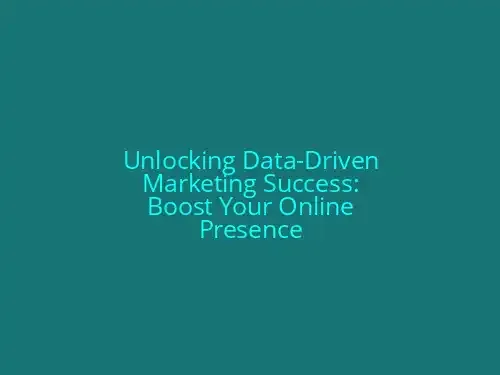
Unlocking Data-Driven Marketing Success: Boost Your Online Presence
### Title: The Power of Data-Driven Marketing: How to Boost Your Online Presence\n### I. Introduction\n#### Why Data-Driven Marketing Matters\nIn todays fast-paced business environment, marketing teams face immense pressure to deliver results that align with the ever-changing consumer landscape. To achieve success, marketers must continuously refine their strategies and adopt innovative approaches that resonate with their target audience. Data-driven marketing has emerged as a game-changer, empowering businesses to make better decisions about their marketing strategy and tactics by providing valuable insights into customer preferences and behavior. By leveraging data, businesses can create highly targeted and personalized campaigns that drive results.\nData-driven marketing is not just about gathering data but also understanding and using it to deliver personalized experiences that resonate with your audience. The ultimate goal is to achieve the highest possible return on investment by delivering the right message to the right person at the right time. This approach is crucial for modern marketing, as it allows businesses to gain a deep understanding of their customers and their behavior.\n#### Brief overview of the importance of data-driven marketing in todays digital landscape\nData-driven marketing is essential in todays digital landscape because it helps businesses stay ahead of the competition. It provides insights into customer behavior and preferences, allowing marketers to tailor their strategies and optimize campaigns for maximum impact. With data-driven marketing, businesses can measure the effectiveness of their campaigns and make data-backed decisions about where to allocate resources for the best results. This approach is critical for improving efficiency and reducing waste in marketing operations.\n#### Mention how businesses can leverage data to personalize customer experiences and improve conversions\nBy analyzing customer data, businesses can gain valuable insights into their needs, preferences, and behavior patterns. These insights can be used to create highly targeted and personalized marketing campaigns that resonate with customers and drive conversions. For example, using demographic data to plan campaigns allows businesses to target specific audience segments with relevant messaging and improve the likelihood of successful conversions.\n#### Summary of the importance of data-driven marketing\nData-driven marketing is vital for businesses seeking to boost their online presence and stay competitive in todays digital landscape. By leveraging data to understand customer behavior and preferences, businesses can create personalized marketing campaigns that drive results and improve conversions. Data-driven marketing empowers businesses to make better decisions about their marketing strategies and tactics, leading to increased efficiency and ROI.### II. Understanding Your Audience\nUnderstanding your audience is crucial in data-driven marketing. Data helps in segmenting the target audience and creating personalized content that resonates with them.\nData provides valuable insights into customer behavior and preferences, enabling businesses to tailor their marketing efforts accordingly. By leveraging demographic data such as age, gender, income, and marital status, companies can develop targeted outreach activities. Geographic segmentation also plays a significant role by grouping customers based on their physical location, facilitating localized marketing campaigns.\nUnderstanding customer behavior is essential in crafting effective marketing strategies. Data-driven insights help identify patterns within user interactions, allowing marketers to refine their content and messaging to better align with audience needs. This approach enhances engagement, conversion rates, and customer satisfaction.\nBy harnessing the power of data, businesses can create a deeper connection with their target audience, resulting in increased loyalty and ultimately driving revenue.\n### End of Section II\n### End of Article### III. Crafting a Data-Driven Marketing Strategy\nCrafting a data-driven marketing strategy involves several key steps. Heres how to set up a data-driven marketing system and leverage data for targeted marketing campaigns:\n1. **Track and Analyze Data**: Utilize tools like Google Analytics to track user behavior, such as website traffic, click-through rates, and conversion rates. This data helps in understanding audience engagement and identifying areas of improvement.\n2. **Data Analysis**: Analyze the data collected to identify trends, patterns, and correlations. This helps in identifying what types of content perform well and where adjustments can be made for better results.\n3. **Targeted Marketing Campaigns**: Use the insights gained from data analysis to create targeted marketing campaigns. This involves segmenting the audience based on demographics, behavior, and preferences, and tailoring content to specific groups.\n4. **Continuous Improvement**: Regularly monitor and analyze data to refine marketing strategies. This ensures that marketing efforts stay aligned with the target audiences evolving needs and behavior.\nBy following these steps, businesses can create effective data-driven marketing strategies that drive conversions, enhance customer experiences, and ultimately boost their online presence.### IV. SEO and Data-Driven Marketing\nThe power of data in SEO lies in its ability to guide keyword research and optimization. By analyzing search trends and user behavior, businesses can identify relevant keywords that drive traffic and conversions. This data-driven approach helps in creating targeted content that resonates with the audience, boosting search engine rankings, and improving user engagement.\nData provides valuable insights into on-page SEO techniques, including meta tag optimization, header tags, and internal linking. Additionally, data analysis helps in identifying technical SEO issues, such as page speed and mobile responsiveness, which can significantly impact search engine rankings.\nData-driven marketing also involves leveraging data to optimize existing content. By analyzing performance metrics like engagement rates and conversion rates, businesses can refine their content strategy, focusing on high-performing content and adjusting underperforming content to better meet audience needs.\nIn summary, data plays a crucial role in SEO by providing actionable insights to create targeted and engaging content, optimize on-page SEO elements, and refine content strategy for improved performance. By integrating data into SEO efforts, businesses can drive more qualified traffic, boost conversions, and ultimately, enhance their online presence.
read more →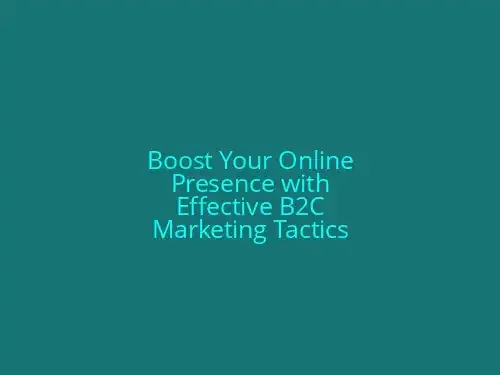
Boost Your Online Presence with Effective B2C Marketing Tactics
**Title: Effective B2C Marketing Tactics for a Strong Online Presence**\n**1. Introduction to B2C Marketing: Definition and Importance, Understanding the Target Audience, and Key Components**\n**Introduction to B2C Marketing**\n### Definition and Importance\nBusiness-to-consumer (B2C) marketing is a crucial aspect of any brands digital strategy. It involves directly promoting products or services to individual consumers through various digital channels such as social media, content marketing, email marketing, and more. The goal of B2C marketing is to attract, engage, and retain customers by creating a strong online presence and providing them with value.\n### Understanding the Target Audience\nTo succeed in B2C marketing, it is essential to understand who your target audience is. This includes factors such as demographics, interests, behaviors, and pain points. By understanding these factors, you can tailor your marketing strategies to effectively communicate with your audience and meet their needs.\n### Key Components of B2C Marketing\nKey components of B2C marketing include:\n- **Content Creation**: Create high-quality, engaging content that resonates with your target audience.\n- **Social Media**: Leverage social media platforms to reach and engage with your audience.\n- **Email Marketing**: Build relationships with your audience through targeted email campaigns.\n- **Search Engine Optimization (SEO)**: Optimize your website and content to rank higher in search engine results.\n- **Analytics and Performance Measurement**: Monitor and measure your performance using analytics tools to optimize and improve strategies.\nEach of these components plays a vital role in creating a strong online presence and driving conversions. By incorporating these elements into your B2C marketing strategy, you can effectively connect with your target audience and drive sales.\n### Key Takeaways\n- B2C marketing involves directly promoting products or services to individual consumers.\n- Understanding your target audience is crucial for effective marketing.\n- Key components of B2C marketing include content creation, social media, email marketing, SEO, and analytics.\nBy understanding these components and how they apply to your B2C marketing strategy, you can create a strong online presence and drive sales.**2. Creating a Strong Brand Identity**\n## Building a Unique Value Proposition\nCreating a strong brand identity is crucial for any business-to-consumer (B2C) marketing strategy. The first step in building a unique value proposition is to understand your target audience deeply. This involves identifying their needs, preferences, and behaviors. By understanding your audience, you can develop a brand identity that resonates with them emotionally and differentiates your brand from competitors.\n## Establishing an Online Presence\nEstablishing a strong online presence is vital for any B2C brand. This includes creating a visually appealing website that effectively communicates your brand’s message and value proposition. Your website should be user-friendly, mobile-responsive, and optimized for search engines to ensure maximum visibility.\n## Consistent Visual Identity\nA consistent visual identity is essential for building brand recognition. This includes using a consistent logo, color palette, typography, and imagery across all marketing materials and channels. This cohesiveness helps in building trust and reliability with your audience.\n## Brand Positioning\nEffective brand positioning clarifies where your brand stands in the marketplace and in the minds of your customers. This involves differentiating your brand from competitors by highlighting unique attributes, values, and experiences that your brand offers. By positioning your brand correctly, you can craft marketing messages that communicate your brand’s unique value proposition clearly and compellingly.\n## Strong Online Presence through SEO and Social Media\nA comprehensive brand awareness strategy should encompass a variety of components, including a strong online presence through SEO and social media. This includes leveraging social media platforms to engage with your audience, creating shareable content that resonates with your target demographic, and utilizing influencer partnerships to expand your reach.\n## Key Elements of Brand Awareness\nKey elements of brand awareness include a strong online presence, content marketing that resonates with your audience, partnerships and collaborations to expand reach, targeted advertising to capture attention, and customer engagement initiatives that foster loyalty and advocacy. By incorporating these elements into your strategy, you can enhance your brand’s visibility and reputation.\n## Consistency and Authenticity\nConsistency and authenticity are vital for building a strong brand identity. This includes maintaining a consistent visual identity, messaging, and tone across all marketing channels and platforms. Additionally, being genuine and transparent in your marketing efforts helps in building trust with your audience.\n## Conclusion\nIn conclusion, creating a strong brand identity is crucial for any B2C marketing strategy. By understanding your target audience, establishing a strong online presence, and consistently communicating your brand’s value proposition, you can build a recognizable and trusted brand that resonates with your audience.**Effective Content Creation**\n\n### Understanding Your Target Audience\nTo create effective content, it is crucial to understand who your target audience is. This involves knowing their demographics, such as age, gender, location, and interests. It also includes understanding their pain points, goals, and motivations. By understanding your audience deeply, you can tailor your content to resonate with them, making it more engaging and relevant.\n### Choosing the Right Format\nDepending on your target audience and the message you want to convey, choose the right format for your content. This can include blog posts, videos, podcasts, infographics, and more. For example, if you are targeting a younger audience, short-form videos or social media posts may be more effective. If you are targeting a professional audience, in-depth blog posts or whitepapers may be more suitable.\n### Optimizing Content for SEO and Social Media\nOptimize your content for both search engines and social media to maximize its reach and engagement. This includes using relevant keywords, meta descriptions, and optimizing images for search engines. For social media, use relevant hashtags and tag relevant influencers to increase visibility and engagement.\n### Creating Engaging and Compelling Calls to Action\nA compelling call to action (CTA) is crucial to drive conversions from your content. Make sure your CTAs are clear, prominent, and actionable. Use action-oriented language and emphasize the benefits of taking the desired action. A well-crafted CTA can significantly boost your conversion rates.\nBy following these guidelines, you can create effective content that resonates with your target audience and drives results for your B2C marketing efforts.**Leveraging Social Media and Influencer Marketing**\nSocial media and influencer marketing play crucial roles in enhancing B2C marketing strategies. Here are key points to consider:\n### Understanding the Power of Social Media\n- **Determine where your customers are hanging out most**. Focus on platforms where your target audience is most active.\n- **Research competitors’ strategies** to understand what works well for them and how you can improve.\n- **Understand platform differences** to share high-quality content that resonates with your audience.\n### Choosing the Right Influencers\n- **Identify influencers with relevant audiences** and experience working with B2C brands.\n- **Check for influencer conflicts** to ensure they dont have competing agreements.\n- **Clear goals** are essential to determine KPIs and the best influencer for the job.\n### Creating Personalized Experiences\n- **Engage actively** to build strong relationships with your audience.\n- **Be responsive** and share your brand’s personality in interactions.\n- **Use high-quality images** that resonate with your followers.\n- **Request reviews and feedback** to improve customer satisfaction.\n### Promoting Values and Telling Stories\n- **Focus on emotional connections** in B2C marketing.\n- **Use contests and giveaways** to encourage engagement and brand awareness.\n- **Ask influencers for reviews** to build trust and credibility.\n- **Highlight unique selling points** and promote brand values.\nBy integrating social media and influencer marketing effectively, B2C businesses can build a strong online presence and connect with their audience in meaningful ways.
read more →